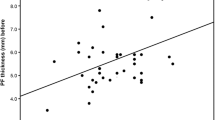Abstract
Objective
Plantar fasciitis (PF) is a common clinical condition that usually resolves with non-operative treatments. Extracorporeal shock wave therapy (ESWT) has been used in the treatment of chronic PF not responding to other conservative measures; however, ESWT devices are expensive and available for daily practice in only few centers (In developing countries). A pneumatic lithotripter is a cheap and readily available device which uses pneumatic shock application for the intracorporeal lithotripsy. The aim of this study was to investigate the clinical efficacy of intracorporeal pneumatic shock therapy (IPST) application for the treatment of chronic PF using a cheap and readily available pneumatic lithotripter.
Methods
A randomized, double-blind, placebo-controlled study was conducted. A total of 50 patients with clinically and radiologically confirmed PF were randomly allocated to either an active- (treatment) (n = 25) or inactive (placebo) (n = 25) group. Under local anesthesia and posterior tibial nerve block, a rigid probe was directly introduced into the calcaneal spur under fluoroscopic control; a standard protocol of 1,000 shock was applied during a single session into the calcaneal spur. The main outcome measure was the patients’ subjective assessment of pain by means of a Visual Analog Scale (VAS) and the Roles and Maudsley Score before the treatment and 6 months later.
Results
At the 6 months, the rate of successful outcomes (excellent + good results) in the treatment group (92%) were significantly higher comparing to the control group (24%) (P < 0.001). Heel pain measured 6 months after using the VAS were 2.04 ± 1.67 in treatment group and 7.16 ± 1.57 in control group as compared to 8.92 ± 1.22 and 9.12 ± 1.23 before the commencement of the treatment. No complications attributable to the procedure such as rupture of the planter fascia, hematoma, or infection were observed during the study.
Conclusions
This pilot study showed that IPST is an effective and safe method of treatment of patients with chronic PF not responding to conservative measures. IPST application should be considered before surgical intervention when the extracorporeal shock devices are not available for daily practice. However, further evaluation of this novel treatment is necessary to understand the exact mechanism of action.



Similar content being viewed by others
References
Basford JR, Malanga GA, Krause DA, Harmsen WS (1998) A randomized controlled evaluation of low-intensity laser therapy: plantar fasciitis. Arch Phys Med Rehabil 79:249–254
Buch M, Knorr U, Fleming L et al (2002) Extracorporeal shockwave therapy in symptomatic heel spurs. An overview. Orthopade 31:637–644
Clement DB, Taunton JE, Smart GW, McNicol KL (1981) A survey of overuse running injuries. Phys Sportsmed 9:47–58
Davis PF, Severud E, Baxter DE (1994) Painful heel syndrome: results of nonoperative treatment. Foot Ankle Int 15:531–535
Denstedt JD, Eberwein PM, Singh RR (1992) The Swiss Lithoclast: a new device for intracorporeal lithotripsy. J Urol 148:1088–1090
Hill JJ, Cutting PJ (1989) Heel pain and body weight. Foot Ankle 9:254–256
Ikeda K, Tomita K, Takayama K (1999) Application of extracorporeal shock wave on bone: preliminary report. J Trauma 47:946–950
James SL, Bates BT, Osternig LR (1978) Injuries to runners. Am J Sports Med 6:40–50
Jerosch J, Schunck J, Liebsch D, Filler T (2004) Indication, surgical technique and results of endoscopic fascial release in plantar fasciitis (E FRPF). Knee Surg Sports Traumatol Arthrosc 12(5):471–477
Kudo P, Dainty K, Clarfield M et al (2006) Randomized, placebo-controlled, double-blind clinical trial evaluating the treatment of plantar fasciitis with an extracoporeal shockwave therapy (ESWT) device: a North American confirmatory study. J Orthop Res 24:115–123
Lapidus P, Guidotti F (1965) Painful heel: report of 323 patients with 364 painful heels. Clin Orthop 39:178–186
Lysholm J, Wiklander J (1987) Injuries to runners. Am J Sports Med 15:168–171
Ogden JA, Alvarez R, Levitt R et al (2001) Shock wave therapy for chronic proximal plantar fasciitis. Clin Orthop Relat Res 387:47–59
Roles NC, Maudsley RH (1972) Radial tunnel syndrome: resistant tennis elbow as a nerve entrapment. J Bone Joint Surg Br 54:499–508
Rompe JD, Furia J, Weill L, Maffulli N (2007) Shock wave therapy for chronic plantar fasciopathy. Br Med Bull 81–82:183–208. doi:10.1093/bmb/ldm005
Rubin G, Witten M (1963) Plantar calcaneal spurs. Am J Orthop 3:38–40
Schulze H, Haupt G, Piergiovanni M, Wisard M, Von Niederhausern W, Senge T (1993) The Swiss Lithoclast: a new device for endoscopic stone disintegration. J Urol 149:15–18
Theodore GH, Buch M, Amendola A et al (2004) Extracorporeal shock wave therapy for the treatment of plantar fasciitis. Foot Ankle Int 25:290–297
Wang CJ, Wang FS, Yang KD et al (2003) Shock wave therapy induces neovascularization at the tendon–bone junction. A study in rabbits. J Orthop Res 21:984–989
Warren BL, Jones CJ (1987) Predicting plantar fasciitis in runners. Med Sci Sports Exerc 19:71–73
Wolgin M, Cook C, Graham C, Mauldin D (1994) Conservative treatment of plantar heel pain: long-term follow up. Foot Ankle Int 15:97–102
Zheng W, Denstedt JD (2000) Intracorporeal lithotripsy. Update on technology. Urol Clin North Am 27:301–313
Author information
Authors and Affiliations
Corresponding author
Rights and permissions
About this article
Cite this article
Dogramaci, Y., Kalaci, A., Emir, A. et al. Intracorporeal pneumatic shock application for the treatment of chronic plantar fasciitis: a randomized, double blind prospective clinical trial. Arch Orthop Trauma Surg 130, 541–546 (2010). https://doi.org/10.1007/s00402-009-0947-0
Received:
Published:
Issue Date:
DOI: https://doi.org/10.1007/s00402-009-0947-0




